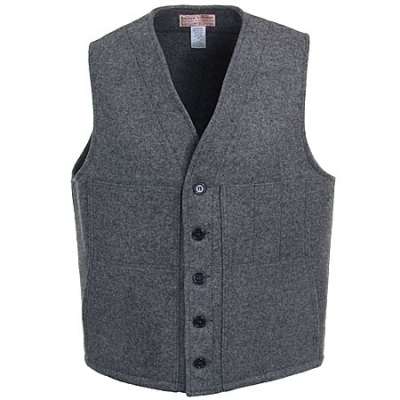Wool is a natural insulator, grown by sheep and other animals. Wool fibers consist of an inner core made of protein, which is covered by overlapping scales. The protein core absorbs up to 30% of its weight in moisture without becoming damp or clammy. The scales are durable and hard, reducing wear on the fibers and repelling liquids. The fibers are strong and elastic, usually wavy, or crimped. Wool contains lanolin, which is a natural water-repellant grease. The fleece of the sheep’s wool protects the animal from the wet and cold by turning away rain and water. The crimp of the wool produces insulating air spaces within the fleece, which reduce the flow of heat. The air near the skin is kept dry, providing better insulation, by the core protein absorbing moisture from this trapped air and passing it towards the outside of the fleece. The elasticity and strength of the fibers allow movement of the fleece without losing the air spaces or breaking the fibers. Besides repelling liquid water, the scales help keep the fleece clean, since their outer ends all point in the direction away from the skin and with the movement of the fleece tend to push any dirt away from the skin.
Wool provides a wide comfort range, essential for sheep and a unique and very helpful feature in outdoor work apparel. The way perspiration is removed from the skin layer and released from the outer surface of the wool creates this refreshing feature. Perspiration is released by the skin and cools the skin as it is released. When perspiration is absorbed by the wool fiber there is a heat reaction that counters the cooling effect at the skin level. The temperature gradient between the warm skin and the colder exterior of the wool garment causes the moisture from perspiration to migrate towards the outer surface of the wool. There it evaporates into the ambient air. The pockets of air trapped within the fabric determine the insulating value of the wool fleece or fabric. The amount of water vapor in the air within the wool fabric is a function of the temperature and the amount of water in the fibers. It also affects the heat conductivity of this air. All else being equal, when the amount of activity or the ambient temperature increases, the body perspires more, the heat conductivity of the air trapped in the wool fabric increases, and the insulating value of the wool decreases. Thus wool clothing not only keeps the skin dry and warm, but also adjusts its degree of insulation to some degree to suit the amount of activity and external temperature.
Different companies have processed the wool with different advantages. A certain technology utilized by SmartWool has created itch-free garments that include all of the benefits of wool. The evaporation level of the wool has also been found to decrease odor for highly perspiring areas like the feet. This also helps control blisters and other discomforts of the feet. Due to the durable crimp of the wool, woolen socks tend to hold their form for long periods while providing cushioning. Wool products are practical and comfortable for daily needs.
Additional properties of wool enhance the value of wool used in work apparel. Wool is fire-resistant, an important property in clothing. It does not melt when heated, a significant factor in reducing the severity of burns from fires. It has a low tendency to collect static electricity, reducing stray electrostatic shocks. Wool can be made to meet a great range of needs and to provide characteristics not found with other fibers.




